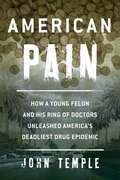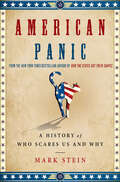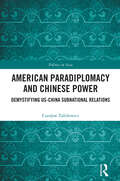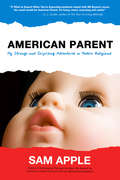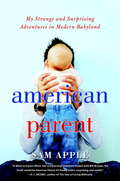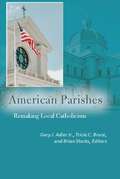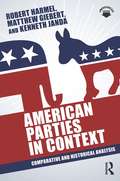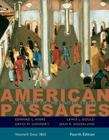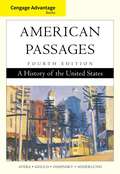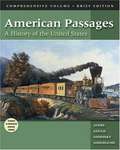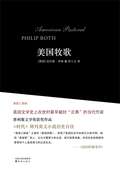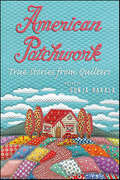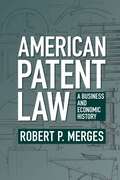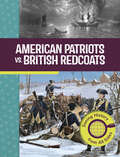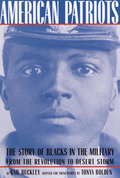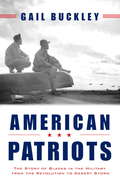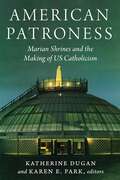- Table View
- List View
American Pain: How a Young Felon and His Ring of Doctors Unleashed America's Deadliest Drug Epidemic
by John Temple* Finalist for the Edgar® Award in Best Fact Crime * New York Post, &“The Post&’s Favorite Books of 2015&” * Suspense Magazine&’s &“Best True Crime Books of 2015&”* Foreword Reviews&’ INDIEFAB Book of the Year in True Crime * Publishers Weekly, Big Indie Book of Fall 2015The king of the Florida pill mills was American Pain, a mega-clinic expressly created to serve addicts posing as patients. From a fortress-like former bank building, American Pain&’s doctors distributed massive quantities of oxycodone to hundreds of customers a day, mostly traffickers and addicts who came by the vanload. Inked muscle-heads ran the clinic&’s security. Former strippers operated the pharmacy, counting out pills and stashing cash in garbage bags. Under their lab coats, the doctors carried guns—and it was all legal… sort of.American Pain was the brainchild of Chris George, a 27-year-old convicted drug felon. The son of a South Florida home builder, Chris George grew up in ultra-rich Wellington, where Bill Gates, Springsteen, and Madonna kept houses. Thick-necked from weightlifting, he and his twin brother hung out with mobsters, invested in strip clubs, brawled with cops, and grinned for their mug shots. After the housing market stalled, a local doctor clued in the brothers to the burgeoning underground market for lightly regulated prescription painkillers. In Florida, pain clinics could dispense the meds, and no one tracked the patients. Seizing the opportunity, Chris George teamed up with the doctor, and word got out. Just two years later Chris had raked in $40 million, and 90 percent of the pills his doctors prescribed flowed north to feed the rest of the country&’s insatiable narcotics addiction. Meanwhile, hundreds more pain clinics in the mold of American Pain had popped up in the Sunshine State, creating a gigantic new drug industry.American Pain chronicles the rise and fall of this game-changing pill mill, and how it helped tip the nation into its current opioid crisis, the deadliest drug epidemic in American history. The narrative swings back and forth between Florida and Kentucky, and is populated by a gaudy and diverse cast of characters. This includes the incongruous band of wealthy bad boys, thugs and esteemed physicians who built American Pain, as well as penniless Kentucky clans who transformed themselves into painkiller trafficking rings. It includes addicts whose lives were devastated by American Pain&’s drugs, and the federal agents and grieving mothers who labored for years to bring the clinic&’s crew to justice.
American Pandemic: The Lost Worlds of the 1918 Influenza Epidemic
by Nancy K. BristowThis readable and compelling account explains the role of race, gender and class, promotion of physical fitness and public education, and America's public health strategy during the influenza epidemics in 1918, 1919, 1920, and 1922. Bristow's work distinguishes itself with her emphasis on influenza epidemics beyond 1918-1919, the roles of physicians and nurses, the importance of public health nursing, and the personal revelation that she lost great-grandparents due to influenza.
American Panic: A History of Who Scares Us and Why
by Mark SteinIn American Panic , New York Times bestselling author Mark Stein traces the history and consequences of American political panics through the years. Virtually every American, on one level or another, falls victim to the hype, intensity, and propaganda that accompanies political panic, regardless of their own personal affiliations. By highlighting the similarities between American political panics from the Salem witch hunt to present-day vehemence over issues such as Latino immigration, gay marriage, and the construction of mosques, Stein closely examines just what it is that causes us as a nation to overreact in the face of widespread and potentially profound change. This book also devotes chapters to African Americans, Native Americans, Catholics, Mormons, Jews, Chinese and Japanese peoples, Communists, Capitalists, women, and a highly turbulent but largely forgotten panic over Freemasons. Striking similarities in these diverse episodes are revealed in primary documents Stein has unearthed, in which statements from the past could easily be mistaken for statements today. As these similarities come to light, Stein reveals why some people become panicked over particular issues when others do not.
American Paper Son: A Chinese Immigrant in the Midwest (Asian American Experience)
by Wayne Hung WongIn the early and mid-twentieth century, Chinese migrants evaded draconian anti-immigrant laws by entering the US under false papers that identified them as the sons of people who had returned to China to marry. Wayne Hung Wong tells the story of his life after emigrating to Wichita, Kansas, as a thirteen-year-old paper son. After working in his father’s restaurant as a teen, Wong served in an all-Chinese Air Force unit stationed in China during World War II. His account traces the impact of race and segregation on his service experience and follows his postwar life from finding a wife in Taishan through his involvement in the government’s amnesty program for Chinese immigrants and career in real estate. Throughout, Wong describes the realities of life as part of a small Chinese American community in a midwestern town. Vivid and rich with poignant insights, American Paper Son explores twentieth-century Asian American history through one person’s experiences.
American Paradiplomacy and Chinese Power: Demystifying US-China Subnational Relations (Politics in Asia)
by Czeslaw TubilewiczThis book investigates contemporary US-China subnational relations and considers the extent to which subnational, national and international power contests inform American states’ strategies of internationalization.Approaching the subject from a constructivist perspective, the book contributes to debates about the relevance of subnational diplomacy to US politics, diplomacy and security. It evaluates the efficacy of Chinese power through influence and interference in co-opting American subnational elites, (re)framing their and the wider public’s social knowledge about China, and (re)shaping the interests, norms and practices guiding relations with China. The book also identifies the limits of Chinese power by exploring how a shift in dominant narratives produces new understandings of opportunities and risks associated with China.Featuring new empirical evidence and a novel theoretical framework, this book will be a valuable resource for students of American politics and foreign relations, paradiplomacy, federal studies, China studies and international relations.
American Parent
by Sam ApplePart memoir, part journalism, part history, part downright strange and hilarious, American Parent takes readers on a unique tour of the world of new mothers and fathers. As Sam Apple embarks on his own journey into parenthood, he decides to put his background in journalism to good use by talking to a wide range of experts. Along the way, Apple visits with the mohel who circumcised him, enters a trance with a childbirth hypnotist, goes on a stakeout with a nanny spy, and attends a lecture on Botox for new mothers. Apple is full of questions, and none is left unexplored: Is the Lamaze method a Stalinist plot? (Yes.) Are newborns really fetuses that are born too soon? (Sort of.) Is there a universal theory that can explain the origins of circumcision in many diverse cultures? (Maybe.) Does it sting when you pour baby shampoo into your own eyes? (Big-time!)And yet for all the unusual twists in this story--at one point Apple fantasizes about a father losing his mind and refusing to remove his BabyBjörn--the strangest twist of all might be that at its core American Parent is a deeply serious and personal book about the way emotionally vulnerable and confused new parents can get lost in the increasingly complex labyrinth of baby products, classes, and fads.
American Parent: My Strange and Surprising Adventures in Modern Babyland
by Sam ApplePart memoir, part journalism, part history, part downright strange and hilarious, American Parent takes readers on a unique tour of the world of new mothers and fathers. As Sam Apple embarks on his own journey into parenthood, he decides to put his background in journalism to good use by talking to a wide range of experts. Along the way, Apple visits with the mohel who circumcised him, enters a trance with a childbirth hypnotist, goes on a stakeout with a nanny spy, and attends a lecture on Botox for new mothers. Apple is full of questions, and none is left unexplored: Is the Lamaze method a Stalinist plot? (Yes.) Are newborns really fetuses that are born too soon? (Sort of.) Is there a universal theory that can explain the origins of circumcision in many diverse cultures? (Maybe.) Does it sting when you pour baby shampoo into your own eyes? (Big–time!) And yet for all the unusual twists in this story—at one point Apple fantasizes about a father losing his mind and refusing to remove his BabyBjörn—the strangest twist of all might be that at its core American Parent is a deeply serious and personal book about the way emotionally vulnerable and confused new parents can get lost in the increasingly complex labyrinth of baby products, classes, and fads.
American Parishes: Remaking Local Catholicism (Catholic Practice in North America)
by Gary J. Adler Jr., Tricia C. Bruce, and Brian StarksParishes are the missing middle in studies of American Catholicism. Between individual Catholics and a global institution, the thousands of local parishes are where Catholicism gets remade. American Parishes showcases what social forces shape parishes, what parishes do, how they do it, and what this says about the future of Catholicism in the United States. Expounding an embedded field approach, this book displays the numerous forces currently reshaping American parishes. It draws from sociology of religion, culture, organizations, and race to illuminate basic parish processes, like leadership and education, and ongoing parish struggles like conflict and multiculturalism. American Parishes brings together contemporary data, methods, and questions to establish a sociological re-engagement with Catholic parishes and a Catholic re-engagement with sociological analysis. Contributions by leading social scientists highlight how community, geography, and authority intersect within parishes. It illuminates and analyzes how growing racial diversity, an aging religious population, and neighborhood change affect the inner workings of parishes. Contributors: Gary J. Adler Jr., Nancy Ammerman, Mary Jo Bane, Tricia C. Bruce, John A. Coleman, S.J., Kathleen Garces-Foley, Mary Gray, Brett Hoover, Courtney Ann Irby, Tia Noelle Pratt, and Brian Starks
American Parties in Context: Comparative and Historical Analysis
by Kenneth Janda Robert Harmel Matthew GiebertRoughly sixty-five years ago, a group of political scientists operating as the "Committee on Political Parties" of the American Political Association thought long and hard about whether the American parties were adequately serving their democracy, and made specific recommendations for improvements. Comparing the parties of this country to those of Great Britain, the Committee found the American parties to be lacking in such fundamentals as clear policy differences, strong and effective organization, and unity of purpose among each party’s representatives in public offices. Starting from that background, this book is intended to significantly enhance students‘ understanding of the American parties today by putting them in broader context. How do the twenty-first century Democrats and Republicans compare to the APSA Committee’s "responsible parties model" of the mid-twentieth? And how do the American parties compare to parties of other democracies around the world, including especially the British parties? Harmel, Giebert, and Janda answer those questions and, in the process, demonstrate that the American parties have moved significantly in the direction of the responsible parties model, but while showing little inclination for implementing the greater discipline the Committee thought essential. Already having provided as much ideological choice as the British parties, the US parties have now edged closer on the other critical requirement of legislative cohesion. The authors show that the latter has resulted "naturally" from the greater homogenization of the meaning of "Democrat" and "Republican" across the country, both within the electorate and now within Congress as well. The dramatic increase in cohesion is not the product of greater party discipline, but rather of sectoral realignments.
American Passage: The Communications Frontier in Early New England
by Katherine GrandjeanKatherine Grandjean shows that the English conquest of New England was not just a matter of consuming territory, of transforming woods into farms. It entailed a struggle to control the flow of information--who could travel where, what news could be sent, over which routes winding through the woods along the early American communications frontier.
American Passage: The History of Ellis Island
by Vincent J. CannatoAmerican Passage explores the remarkable saga of America’s landmark port of entry, from immigration post to deportation center to mythical icon.“A finely honed account that encompasses both the human story of the immigrant experience, often a sad one, and the political and bureaucratic responses.” —Boston GlobeFor most of New York's early history, Ellis Island had been an obscure little island that barely held itself above high tide. Today the small island stands alongside Plymouth Rock in our nation's founding mythology as the place where many of our ancestors first touched American soil.American Passage captures a time and a place unparalleled in American immigration and history, and articulates the dramatic and bittersweet accounts of the immigrants, officials, interpreters, and social reformers who all played an important role in Ellis Island's chronicle. In this sweeping, often heart-wrenching epic, historian Vincent J. Cannato reveals that the history of Ellis Island is ultimately the story of what it means to be an American.“By bringing us the inspiring and sometimes unsettling tales of Ellis Island, Vincent Cannato’s American Passage helps us understand who we are as a nation.” —New York Times bestselling author Walter Isaacson“Cannato resists the temptation to sentimentalize Ellis Island. He understands that, now as then, immigration is an issue that leaves Americans uncomfortable and contentious, even as it continues to bring new blood and energy into the country. Ellis Island may have been converted into something of a feel-good theme park, but the questions it raises remain unresolved.” —Washington Post
American Passages: A History Of The United States
by David M. Oshinsky Lewis L. Gould Edward L. Ayers Jean R. SoderlundNIMAC-sourced textbook
American Passages: A History of the United States
by Lewis Gould David Oshinsky Edward Ayers Jean SoderlundWith a unique attention to time as the defining nature of history, CENGAGE ADVANTAGE BOOKS: AMERICAN PASSAGES: A HISTORY OF THE UNITED STATES, 4e, offers students a view of American history as a complete, compelling narrative. AMERICAN PASSAGES emphasizes the intertwined nature of three key characteristics of time--sequence, simultaneity, and contingency. With clarity and purpose, the authors convey how events grow from other events, people's actions, and broad structural changes (sequence), how apparently disconnected events occurred in close chronological proximity to one another and were situated in larger, shared contexts (simultaneity), and how history suddenly pivoted because of events, personalities, and unexpected outcomes (contingency).
American Passages: A History of the United States, Brief Edition
by David M. Oshinsky Lewis L. Gould Edward L. Ayers Jean R. SoderlundAMERICAN PASSAGES, Brief Edition is a survey of U.S. History that uses online resources and a fully integrated, text-specific Web site to heighten students' awareness and understanding of the past. Crafted from the comprehensive text of the same title, this concise text follows the chronological contours of U.S. history. Each of its 32 chapters focuses on a discrete set of years--allowing the authors to weave events, movements, and groups of people into a unified narrative. The narrative helps students see the ways that different themes and issues in American history have interacted, and allows them to make connections between those themes and issues. Integrated references to the book's Web site and to AMERICAN JOURNEYS ONLINE--a cross-referenced, hyperlinked library of primary sources that are organized by topic--allow students to experience history from the vantage of those who lived it.AMERICAN PASSAGES: A HISTORY OF THE UNITED STATES, Brief Edition is available in the following split options: American Passages, Comprehensive, Brief Edition, First Edition (Chapters 1-32), ISBN: 0155049518; American Passages, Volume I: To 1877, Brief Edition, First Edition (Chapters 1-16), ISBN: 0155051172; American Passages, Volume II: Since 1863, Brief Edition, First Edition (Chapters 15-32), ISBN: 0155051237.
American Pastimes: The Very Best of Red Smith (The Library of America)
by Daniel Okrent Red SmithWalter Wellesley "Red" Smith was the most widely read sportswriter of the last century and the first to win the Pulitzer Prize for commentary. From the 1940s to the 1980s, his nationally syndicated columns for the New York Herald Tribune and later for The New York Times traversed the world of sports with literary panache and wry humor. "I've always had the notion," Smith once said, "that people go to spectator sports to have fun and then they grab the paper to read about it and have fun again." Now, writer and editor (and inventor of Rotisserie League Baseball) Daniel Okrent presents the best of Smith's inimitable columns--miniature masterpieces that remain the gold standard in sportswriting.Here are Smith's indelible profiles of sports luminaries, which show his gift for distilling a career's essence in a single column. Unforgettable accounts of historic occasions--Bobby Thompson's Shot Heard 'Round the World, Don Larsen's perfect game in the 1956 World Series, the first Ali-Frazier fight--are joined by more offbeat stories that display Smith's unmistakable wit, intelligence, and breadth of feeling. Here, too, are more personal glimpses into Smith's life and work, revealed in stories about his lifelong passion for fishing and in "My Press-Box Memoirs," a 1975 reminiscence for Esquire collected here for the first time.A Special Publication of The Library of America.
American Pastoral (Mandarin Edition)
by Philip RothIt is an elegy for all our century's promises of prosperity, civic order, and domestic bliss. Swede Levov, a legendary athlete at his Newark high school, who grows up in the booming postwar years to marry a former Miss New Jersey, inherit his father's glove factory, and move into a stone house in the idyllic hamlet of Old Rimrock. And then one day in 1968, Swede's beautiful American luck deserts him. "美国三部曲"之首的 美国牧歌 体现了美国社会中由来已久的冲突 相信"美国梦"的人 以为只要努力和正派 就可美梦成真 然而历史的悲剧性常常和个人是否努力和正派无关
American Patchwork: True Stories from Quilters
by Sonja HakalaFor those who enjoyed the honesty and insight of How to Make an American Quilt, this is a moving collection of personal stories that highlight the laughter, sadness, friendships, frustrations, and triumphs shared by the more than 21 million people across the country who call themselves quilters.These touching tales from sixty-seven contributors nationwide form a patchwork of their own in the words of each individual's unique narrative. From the quilt that reunited a family divided by war and an ocean to the twenty-two foot banner that accompanied a dying woman on her last journey, American Patchwork is sure to capture the hearts of quilters and quilt lovers everywhere.Wonderfully varied, instructive, nostalgic, amusing, and often poignantly written, this gem of a book will be treasured for years to come.
American Patent Law: A Business and Economic History
by Robert P. MergesStudents and established scholars of intellectual property law often look for historical context when trying to understand the development and present-day contours of IP rules and systems. American Patent Law supplies this context, offering readers a comprehensive account of the evolution of the US patent system and patent doctrine beginning in 1790. From the technologies for harvesting wood and shoemaking in the earliest periods to computer software and biotechnology of the present, each chapter of the book covers the characteristic technologies of each historical era. The book also describes how businesspeople in each era acquired and enforced patents and used patents as the foundation of various business arrangements. This book is a landmark in the history of technologies, the US patent system, and the way private actors have deployed patents across American history.
American Patented Brace 1829-1924: An Illustrated Directory of Patents
by Ronald W. PearsonThis is a vastly expanded successor to Dr. Pearson s earlier Guide to American Brace Patents 1829 1910. Not only are many newly discovered patents included, but these are now cross-indexed and illustrated and, for the first time, the author provides an indication of their rarity. Over 500 brace patents are listed alphabetically by patentee name and chronologically by date and patent number. There is a third index that lists patents by type of brace in four major categories: brace ratchet patents, corner brace patents, brace wrench patents, and brace combination tool patents. An invaluable reference for anyone having an interest in these fascinating examples of American ingenuity.
American Patriots vs. British Redcoats
by Emma Carlson-BerneThe American Revolution was a fight between two groups with different ways of thinking. One group wanted Great Britain to keep control of the American colonies. The other wanted the colonies to have independent rule. Both thought they were right. Readers will examine both sides of the conflict, gaining a greater understanding of this pivotal period in U.S. history.
American Patriots: A Short History of Dissent
by Ralph YoungA concise history that proves that dissent is patrioticThe history of America is a history of dissent. Protests against the British Parliament’s taxation policies led to the American Revolution and the creation of the United States. At the Constitutional Convention the founders put the right to protest in the First Amendment of the Bill of Rights. In the nineteenth century, dissenters protested against the War of 1812 and the Mexican War, they demanded the abolition of slavery, suffrage for women, and fair treatment for workers. In the twentieth century, millions of Americans participated in the Civil Rights Movement, the antiwar movement, and second-wave feminism. In the twenty-first century, hundreds of thousands protested the war in Iraq, joined the 2011 Occupy movement, the 2017 Women’s March, and the 2020 Black Lives Matter uprisings. The crowds grew larger than ever, but the sentiments expressed were familiar. There have been dissenting Americans for as long as there has been an America.In American Patriots, historian Ralph Young chronicles the key role dissent has played in shaping the United States. He explains that activists are not protesting against America, but pushing the country to live up to its ideals. As he guides the reader through the history of protest, Young considers how ordinary Americans, from moderates to firebrands, responded to injustice. He highlights the work of organizations like SNCC and ACT UP, and he follows iconic individuals like Ida B. Wells-Barnett and Woody Guthrie, charting the impact of their dissent. Some of these protesters are celebrated heroes of American history, while others are ordinary people, frequently overlooked, whose stories show that change is often accomplished through grassroots activism.Yet not all dissent is equal. In 2021, thousands of rioters stormed the US Capitol, and Americans on both sides of the aisle watched the destruction with horror. American Patriots contrasts this attack with the long history of American protest, and challenges us to explore our definition of dissent. Does it express a legitimate grievance or a smokescreen for undermining democracy? What are the limits of dissent? Where does dissent end and sedition begin?In a time when legitimate dissent is framed as unpatriotic, Young reminds us of the dissenters who have shaped our country’s history. American Patriots is a necessary defense of our right to demand better for ourselves, our communities, and our nation.
American Patriots: A Young People's Edition
by Tonya Bolden Gail Lumet BuckleyThey fought on Lexington Green the first morning of the Revolution and survived the bitter cold winter at Valley Forge. They stormed San Juan Hill with Theodore Roosevelt's Rough Riders and manned an anti-aircraft gun at Pearl Harbor. They are the black Americans who fought, often in foreign lands, for freedoms that they did not enjoy at home.Adapted for young readers, this dramatic story brings to life the heroism of people such as Crispus Attucks, Benjamin O. Davis, Charity Adams, and Colin Powell, and captures the spirit that drove these Americans to better their lives and demand of themselves the highest form of sacrifice.From the Hardcover edition.
American Patriots: The Story of Blacks in the Military, from the Revolution to Desert Storm
by Gail BuckleyA dramatic and moving tribute to the military's unsung heroes, American Patriots tells the story of the black servicemen and women who defended American ideals on the battlefield, even as they faced racism in the ranks and segregation on the home front. Through hundreds of original interviews with veterans of every war since World War I, historic accounts, and photographs, Gail Buckley brings these heroes and their struggles to life. We meet Henry O. Flipper, who withstood silent treatment from his classmates to become the first black graduate of West Point in 1877. And World War II infantry medic Bruce M. Wright, who crawled through a minefield to shield a fallen soldier during an attack. Finally, we meet a young soldier in Vietnam, Colin Powell, who rose through the ranks to become, during the Gulf War, the first black chairman of the Joint Chiefs of Staff. Fourteen years in the making, American Patriots is a landmark chronicle of the brave men and women whose courage and determination changed the course of American history.
American Patroness: Marian Shrines and the Making of US Catholicism (Catholic Practice in the Americas)
by Katherine Dugan and Karen E. ParkA vital collection of interdisciplinary essays that illuminates the significance of Marian shrines and promises to teach scholars how to “read” them for decades to come.American Patroness: Marian Shrines and the Making of US Catholicism is a collection of twelve essays that examine the historical and contemporary roles of Marian shrines in US Catholicism. The essays in this collection use historical, ethnographic, and comparative methods to explore how Catholics have used Marian devotion to make an imprint on the physical and religious landscape of the United States. Using the dynamic malleability of Marian shrines as a starting place for studying US Catholicism, each chapter reconsiders the American religious landscape from the perspective of a single shrine to Mary and asks: What does this shrine reveal about US Catholicism and about American religion?Each of the contributors in American Patroness examines why and how Marian shrines persist in the twenty-first century and subsequently uses that examination to re-read contemporary US Catholicism. Because shrines are not neutral spaces—they reflect and shape the elastic yet strict boundaries of what counts as Catholic identity, and who controls prayer practices—the studies in this collection also shed light on the contested dynamics of these holy sites. American Patroness demonstrates that Marian shrines continue to be places where an American Catholic identity is continuously worked on, negotiations about power occur, and Marian relationships are fostered and nurtured in spaces that are simultaneously public and intimate.
American Pendulum: Recurring Debates in U.S. Grand Strategy
by Christopher HemmerAs new presidential administrations come into power, they each bring their own approach to foreign policy. No grand strategy, however, is going to be completely novel. New administrations never start with a blank slate, so it is always possible to see similarities between an administration and its predecessors. Conversely, since each administration faces novel problems and operates in a unique context, no foreign policy strategy is going to be an exact replica of its predecessors. In American Pendulum, Christopher Hemmer examines America's grand strategic choices between 1914 and 2014 using four recurring debates in American foreign policy as lenses. First, how should the United States balance the trade-offs between working alone versus working with other states and international organizations? Second, what is the proper place of American values in foreign policy? Third, where does the strategic perimeter of the United States lie? And fourth, is time on the side of the United States or of its enemies? Offering new readings of debates within the Wilson, Truman, Nixon, Bush, and Obama administrations, Hemmer asserts that heated debates, disagreements, and even confusions over U.S. grand strategy are not only normal but also beneficial. He challenges the claim that uncertainties or inconsistences about the nation's role in the world or approach to security issues betray strategic confusion or the absence of a grand strategy. American foreign policy, he states, is most in danger not when debates are at their most pointed but when the weight of opinion crushes dissent. As the United States looks ahead to an increasingly multipolar world with increasing complicated security issues, Hemmer concludes, developing an effective grand strategy requires ongoing contestation and compromises between competing visions and policies.
